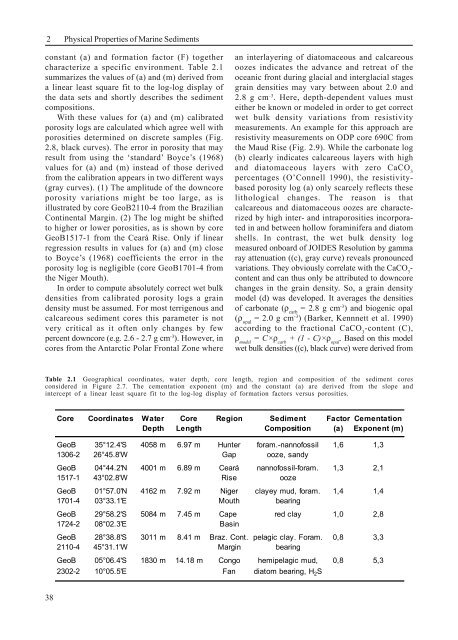2 Physical Properties of Marine Sediments - Blogs Unpad
2 Physical Properties of Marine Sediments - Blogs Unpad
2 Physical Properties of Marine Sediments - Blogs Unpad
You also want an ePaper? Increase the reach of your titles
YUMPU automatically turns print PDFs into web optimized ePapers that Google loves.
2<strong>Physical</strong> <strong>Properties</strong> <strong>of</strong> <strong>Marine</strong> <strong>Sediments</strong>constant (a) and formation factor (F) togethercharacterize a specific environment. Table 2.1summarizes the values <strong>of</strong> (a) and (m) derived froma linear least square fit to the log-log display <strong>of</strong>the data sets and shortly describes the sedimentcompositions.With these values for (a) and (m) calibratedporosity logs are calculated which agree well withporosities determined on discrete samples (Fig.2.8, black curves). The error in porosity that mayresult from using the ‘standard’ Boyce’s (1968)values for (a) and (m) instead <strong>of</strong> those derivedfrom the calibration appears in two different ways(gray curves). (1) The amplitude <strong>of</strong> the downcoreporosity variations might be too large, as isillustrated by core GeoB2110-4 from the BrazilianContinental Margin. (2) The log might be shiftedto higher or lower porosities, as is shown by coreGeoB1517-1 from the Ceará Rise. Only if linearregression results in values for (a) and (m) closeto Boyce’s (1968) coefficients the error in theporosity log is negligible (core GeoB1701-4 fromthe Niger Mouth).In order to compute absolutely correct wet bulkdensities from calibrated porosity logs a graindensity must be assumed. For most terrigenous andcalcareous sediment cores this parameter is notvery critical as it <strong>of</strong>ten only changes by fewpercent downcore (e.g. 2.6 - 2.7 g cm -3 ). However, incores from the Antarctic Polar Frontal Zone wherean interlayering <strong>of</strong> diatomaceous and calcareousoozes indicates the advance and retreat <strong>of</strong> theoceanic front during glacial and interglacial stagesgrain densities may vary between about 2.0 and2.8 g cm -3 . Here, depth-dependent values musteither be known or modeled in order to get correctwet bulk density variations from resistivitymeasurements. An example for this approach areresistivity measurements on ODP core 690C fromthe Maud Rise (Fig. 2.9). While the carbonate log(b) clearly indicates calcareous layers with highand diatomaceous layers with zero CaCO 3percentages (O’Connell 1990), the resistivitybasedporosity log (a) only scarcely reflects theselithological changes. The reason is thatcalcareous and diatomaceous oozes are characterizedby high inter- and intraporosities incorporatedin and between hollow foraminifera and diatomshells. In contrast, the wet bulk density logmeasured onboard <strong>of</strong> JOIDES Resolution by gammaray attenuation ((c), gray curve) reveals pronouncedvariations. They obviously correlate with the CaCO 3-content and can thus only be attributed to downcorechanges in the grain density. So, a grain densitymodel (d) was developed. It averages the densities<strong>of</strong> carbonate (ρ carb= 2.8 g cm -3 ) and biogenic opal(ρ opal= 2.0 g cm -3 ) (Barker, Kennnett et al. 1990)according to the fractional CaCO 3-content (C),ρ model= C×ρ carb+ (1 - C)×ρ opal. Based on this modelwet bulk densities ((c), black curve) were derived fromTable 2.1 Geographical coordinates, water depth, core length, region and composition <strong>of</strong> the sediment coresconsidered in Figure 2.7. The cementation exponent (m) and the constant (a) are derived from the slope andintercept <strong>of</strong> a linear least square fit to the log-log display <strong>of</strong> formation factors versus porosities.Core Coordinates Water Core Region Sediment Factor CementationDepth Length Composition (a) Exponent (m)GeoB 35°12.4'S 4058 m 6.97 m Hunter foram.-nann<strong>of</strong>ossil 1,6 1,31306-2 26°45.8'W Gap ooze, sandyGeoB 04°44.2'N 4001 m 6.89 m Ceará nann<strong>of</strong>ossil-foram. 1,3 2,11517-1 43°02.8'W Rise oozeGeoB 01°57.0'N 4162 m 7.92 m Niger clayey mud, foram. 1,4 1,41701-4 03°33.1'E Mouth bearingGeoB 29°58.2'S 5084 m 7.45 m Cape red clay 1,0 2,81724-2 08°02.3'E BasinGeoB 28°38.8'S 3011 m 8.41 m Braz. Cont. pelagic clay. Foram. 0,8 3,32110-4 45°31.1'W Margin bearingGeoB 05°06.4'S 1830 m 14.18 m Congo hemipelagic mud, 0,8 5,32302-2 10°05.5'E Fan diatom bearing, H 2 S38
















